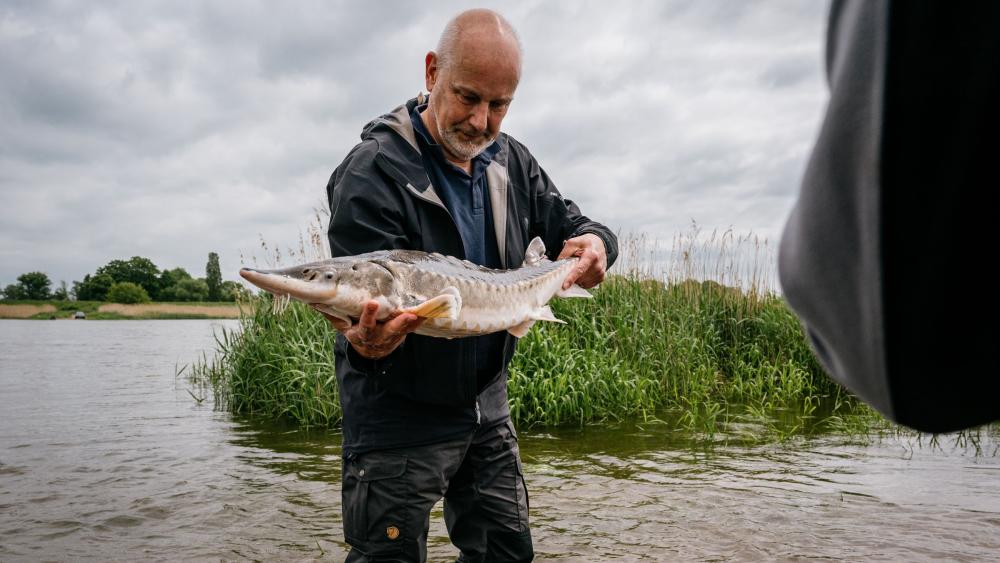
IGB researcher Jörn Geßner holds a young sturgeon. These fascinating fish have lived on Earth for around 250 million years. In that long time, their appearance has changed very little: Their skin is covered with long rows of bones that protect them from predators. | © Jacobia Dahm
There is literally no place on earth, no matter how inhospitable, where life does not exist. Take the river in Mexico where David Bierbach is researching the lives of two species of fish. This river is fed by springs of volcanic origin that are very rich in hydrogen sulphide. “This makes the water highly toxic to anything with more than one cell,” explained the biologist. Since hydrogen sulphide and oxygen react in the water, it is oxygen-free, which can be seen with the naked eye by its milky colour. In the organism, hydrogen sulphide binds to the same proteins as oxygen, preventing cells from producing adenosine triphosphate (ATP) and therefore from functioning. However, two species of fish – the sulphur molly (Pocilia sulphuraria) and the widemouth gambusia (Gambusia eurystoma) – have adapted to these hostile conditions: They have a protein adaptation that prevents hydrogen sulphide from binding to proteins in the mitochondria. This makes the water less toxic for both species. These fish have existed in this body of water, which is roughly the size of Lake Müggelsee, for several 100,000 years and they can only survive in this water – their organism is highly adapted.
Successful strategies against sulphur and predators
Of course, these fish species also need oxygen. They have developed larger heads with larger gills for this purpose. There is a thin, slightly oxygenated film on the surface of the water, which the fish allow to pass over their gills, absorbing the oxygen it contains. They need a lot of it because the water temperature is also extreme at well over 30 degrees. At such high temperatures, metabolic processes speed up and cellular respiration increases. Oxygen is also needed to cope with the sulphur that penetrates through the gills and body surface. Food, on the other hand, is plentiful: Because the sulphurous water is rich in bacteria, the fish are found in very high densities – which in turn attracts birds. The fish have also developed a counter-strategy. “Hiding is not an option because the fish have to be on the surface. To reduce the pressure from predators, the fish dive up and down in rapid, coordinated repetitions. From the outside, it looks like a giant Mexican wave running through the river, made up of hundreds of thousands of tiny fish. This ‘wave’ deters the birds and extends the time before the next attack,” explained David Bierbach.
Sulphur molly.| © Matthias Schulze
It will be difficult for the fish if temperatures continue to rise. “Since the environment to which they have adapted is extremely hostile, they are already at their limit,” commented David Bierbach. The researchers were able to observe this when the banks of one section of the river were dredged. A large surge of warm spring water entered the river, temporarily warming it by one degree and introducing more sulphur into the river. “As a result, a wave of death swept through the river because these small changes were unbearable for most individuals,” reported the researcher. The conditions only lasted for a short time, and some fish survived. However, the scientist predicts that if climate change causes temperatures to rise slightly in the long term, the two species are likely to become extinct.
Armoured wanderer: the sturgeon
Sturgeons have been proving their resilience for around for 250 million years. They have a bone armour that repels predators – even if today’s armour does not resemble that of the past. “The five-row bone shield is just a remnant, made of the same material but much smaller,” stated Jörn Geßner. However, it does not help much against humans, who quickly learned to hunt sturgeon successfully: by the end of the 19th century, fishermen were catching 10,000 sturgeon a year in the River Elbe, a highly coveted prize, as each of the fish, which can grow to four-and-a-half metres in length, can yield up to 300 kg of meat.
“For millions of years, the sturgeon’s strategy was to reproduce at different times and places in freshwater and then migrate to the sea to live and grow. This was ideal for building up large populations over the long term,” explained Jörn Geßner. The migrations are genetically pre-programmed and not an individual decision by the sturgeon. Most fish always return to the river where they hatched. However, sturgeon can change their habitat over long periods of time. The European sturgeon, for example, migrated north past the Iberian Peninsula after the last Ice Age. “It took the sturgeon 800 years just to get from the Seine to the Rhine. There are always just a few strays that escape and build up new populations over the centuries,” remarked Jörn Geßner.
However, this only works as long as the adult sturgeon are not caught – and the watercourses are intact. To spawn, the sturgeon needs clean gravel, free of sand and organic material, so that water can flow through it and the eggs, which adhere to the gravel, are supplied with oxygen-rich freshwater. As industrialisation has progressed, water quality has deteriorated and eggs have died in the spawning grounds due to pollutants, which in turn have been lost as rivers have been dredged to allow larger ships to pass. Climate change is also affecting the sturgeon’s habitat. Spring floods clean the gravel banks, but these periods are becoming increasingly shorter or are shifting, further reducing the conditions for successful reproduction. In some regions, summer temperatures are already reaching the tolerance limits of juvenile fish, which means that entire regions of the species’ historical distribution will be lost in the future. “These changes are now occurring at a high rate, leaving too little time for long-lived species with long generation cycles to adapt,” stated Jörn Geßner. Whether it will be possible to reintroduce the sturgeon to the Baltic Sea and the River Oder is still uncertain. Its defensive shell, that much is certain, will be of little use.
Feedback mechanisms influence population resilience
Lynn Govaert studies unicellular ciliates to find out what conditions the organisms need to live and reproduce – and what stresses them. With Colpidium striatum and Paramecium aurelia, she has selected two species that compete with each other for the same food, but have contrasting preferences for their optimal ambient temperature: While Paramecium likes it warm in order to divide, Colpidium prefers lower temperatures. In her experimental set-up, Lynn Govaert put the two species in a system and varied the temperature and salinity of the water. “We wanted to know what happens when two environmental parameters change at the same time and the organisms also have to compete for food,” she said. The researchers measured how cell size and population density changed in both ciliate species: Normally, cell size determines when an individual divides. If there are many individuals in a habitat, their cell size decreases and the reproduction rate, and thus the population density, decreases accordingly.
However, this is not always the case; environmental conditions also have an influence on the reproduction rate and thus on the resilience of organisms, as Lynn Govaert was able to show. “We observed, for example, that Colpidia had very large cell sizes at one point, but the population density did not increase because the organisms did not divide. They were obviously stressed by changes in their environment – in this case, higher temperatures,” reported the researcher. Fewer individuals and higher temperatures also provide good growth conditions for the bacteria that the protozoa feed on – yet cell division rates did not increase in the experiment.
A feedback between the population density and certain characteristics of the ciliates can be disrupted depending on the environmental conditions. “This suggests that these organisms are less resilient,” commented Lynn Govaert. Her work shows that living organisms do not “simply” react to environmental changes: Environmental change can also trigger changes in feedbacks within species’ populations, which can either amplify or counteract their responses to environmental change.
2022 River Oder disaster: resilient fish stocks when the river flows freely and provides refuges
Around 1,000 tons of fish died in the Oder ecological disaster in the summer of 2022. A team led by Christian Wolter investigated the resilience of fish stocks in Europe’s last permeable river system in the aftermath of these events. The researchers assessed the decline rates of the stocks, taking into account natural population fluctuations: Depending on the section of the Oder, fish density declined by up to 76 per cent. “The first piece of good news is that all species survived,” noted the researcher. Larger fish species and those that tend to live in the middle channel of the river were more likely to be affected. Species that prefer to live near the banks fared better because the golden algae was not as abundant there as in the deeper water. The declines recorded are relative; tens of thousands of individuals per hectare were affected in the case of smaller species, but only a few specimens were affected in the case of large fish.
Another piece of good news: the populations have continued to recover. “In 2023, there was a prolonged spring flood and therefore good growth conditions. There was also a moratorium on industrial fishing, so no fish were caught in the Oder. That’s why we had a great starting cohort with lots of young fish,” reported Christian Wolter. The researchers expect that all stocks can recover by 2026 or 2027. Some fish species have already reached this stage: the gudgeon, for example, reached its previous population size in just one year.
In addition to the good external conditions, the fish are helped by two mechanisms: they have a very high reproductive potential and they are mobile. One fish can produce up to a million eggs, from which many fish can hatch if there is sufficient spawning area, as was the case in 2023. “This means that you only need a few individuals and can still have a good year if the conditions are right,” explained Christian Wolter. Fish reproduce for about ten to 15 years, so the chance of at least one good year is high, which contributes to the resilience of the species.
In 2022, the mobility combined with the passability of the Oder meant that fish were able to move from sections with deteriorating water quality to safe areas such as clean tributaries or riverbanks. “We don’t know to what extent individual experiences played a role in the evasive movements,” said Christian Wolter. For example, low water levels in the summer of 2018 led to fish migrating downstream into the Lower Oder.
Overall, therefore, the fish stocks in the River Oder are very resilient and the creatures have many characteristics that favour their survival. “However, fortified banks and migration barriers in the river, which prevent fish from moving to secondary waters, significantly limit the resilience of the fish,” commented Christian Wolter. The naturalness of the environment in which individuals and populations live largely determines their resilience.










